Breathe in, exhale. If you’re a CTO, founder, or anyone with “bringing in good developers” on your to-do list, you’ve heard of Turing. Maybe you’ve even read their pitch at two in the morning, somewhere between your seventh coffee and fifteenth technical interview. “Deep vetting. AI matching. Global scale.” The promise? Handpicked Silicon Valley-caliber talent from halfway across the world, all delivered with algorithmic precision and almost zero stress.
Except you’ve been burned before. The “unicorn” who ghosted after onboarding. The “top 1%” engineer who struggled with a timezone-friendly hello. The platform that promised match after match, but delivered more “close enough” than you’d care to admit.
You’re not alone. Speed, quality, and remote risk are the hurdles. Turing claims to vault them at Olympic height—AI-driven vetting, vast developer network, and (allegedly) instant matching. But most buyers know that real hiring isn’t a science experiment—it’s personal, messy, and full of tradeoffs that can sink projects before they start.
So: What makes Turing’s model tick? Where does it deliver on the hype, and where does it quietly ask you to lower your expectations? More importantly, what does the rest of the market look like in 2025, when you want to hire vetted developers but don’t want to hand your fate to a chatty chatbot or a black-box algorithm?
If you’re considering Turing—or growing wary of its all-knowing, all-matching AI—this review cuts through the pitch and the fine print. We’ll break down the platform, highlight where it shines (and where it doesn’t), share real buyer and developer experiences, and stack Turing up against the most credible alternatives, including those that live up to their promised expectations.
Ready for the untarnished, unsponsored look at Turing and its rising rivals? Keep reading.
Turing Alternatives for People Who’ve Had Enough “AI Matching”
You’re paying for outcomes, not optimism. Here are the platforms that buyers stick with after the trial ends.
Lemon.io: The Only Club Where “98% Rejection Rate” Is a Selling Point
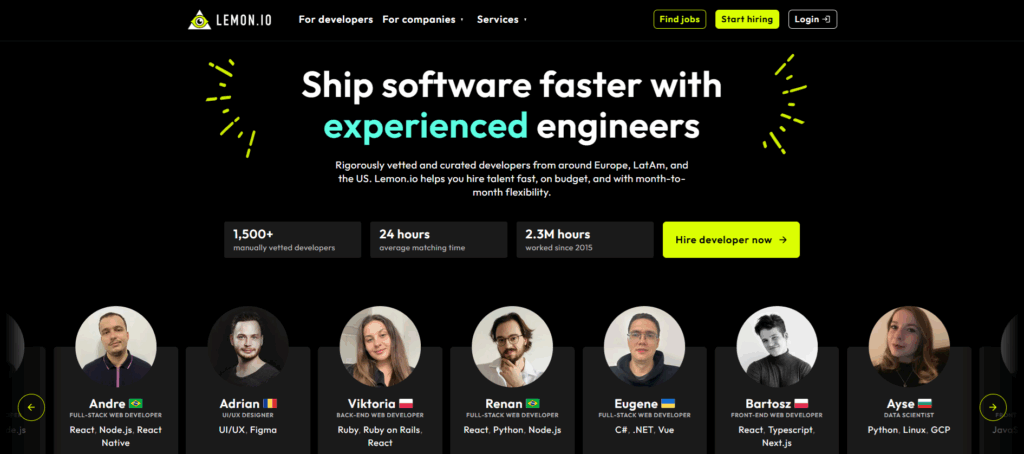
Lemon.io is where developer hopefuls go to be rejected (and clients finally get what they pay for). Their pitch is simple: If you want a developer with actual senior chops—someone who knows the difference between writing code and solving your business problem—they’ve probably already turned away ten others to keep the pool clean. Here, “vetting” isn’t a buzzword. It’s an Olympic sport.
What you get: Direct, honest matching—no sugarcoating if they can’t fill your niche request, no mystery fees, no endless “fast-track” interviews just to end up with someone learning React on the fly. Most matches happen in a week or less, and if your needs line up with their pool (think senior devs, mostly Eastern European, mostly night-owl compatible with the US/EU), you’ll get a dev who’s already passed a real code review and an actual English conversation, not just a grammar quiz.
Buyers say it best: G2 reviews are full of comments about Lemon’s “shockingly fast.”
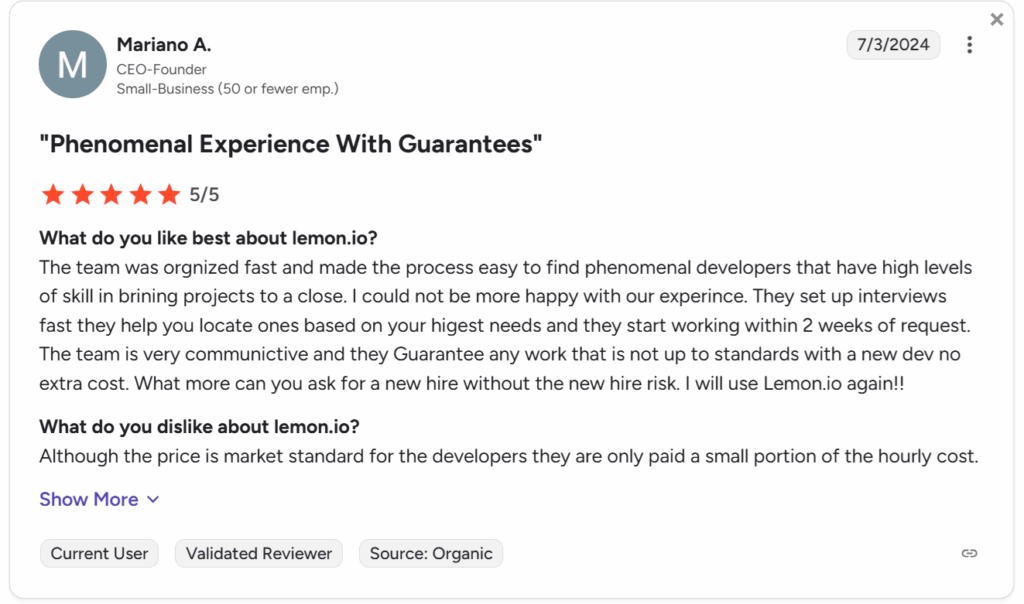
Many reviews praise Lemon.io’s “responsive and genuinely helpful support,” as well as the “no-nonsense matching.”
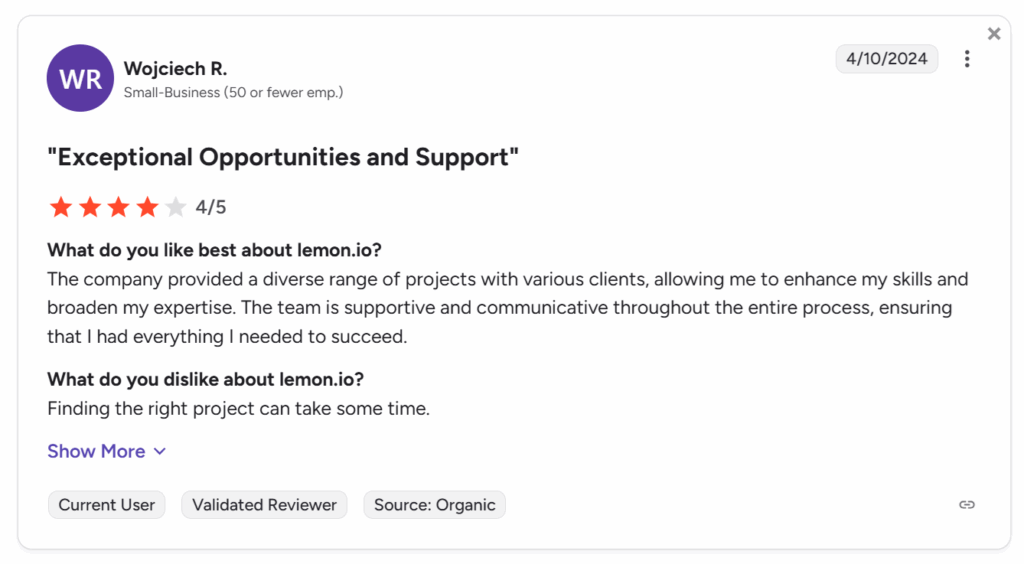
On the downside? If your ask is too niche or your budget’s set to “cheapest on Earth,” you might end up out of luck—or told so, upfront.
Lemon.io doesn’t try to be for everyone, and that’s the point. If you want cheap, there’s Upwork. If you want a high-gloss pitch and “top 3%” math, hi Toptal. If it’s ruthless selectivity, honest support, real matches, and no B.S., you’re in the right fruit basket.
Toptal: White-Glove, White-Collar, and White-Hot Price Tag

Toptal is the brand your CFO recognizes—the one with “top 3% only” all over their pitch deck. If you need a team that signs NDAs before saying hello and you’re building the kind of app that ends up in quarterly reports, Toptal is still the old-school favorite.
What you get: Battle-tested process, enterprise credibility, and a well-oiled recruiting funnel. They’ll flash their Fortune 500 logos and legendary vetting at you until you believe it (and yes, their developers are generally strong). It’s a safe bet if you’re spending other people’s money, or need a developer bench that looks good on a board slide.
On the plus side: Teams love the speed—one reviewer got “a great candidate fast and the whole process felt smooth, start to finish.” For a lot of buyers, the big win is not just quality, but “the overall experience” feeling like someone put a turbo on your hiring sprint.
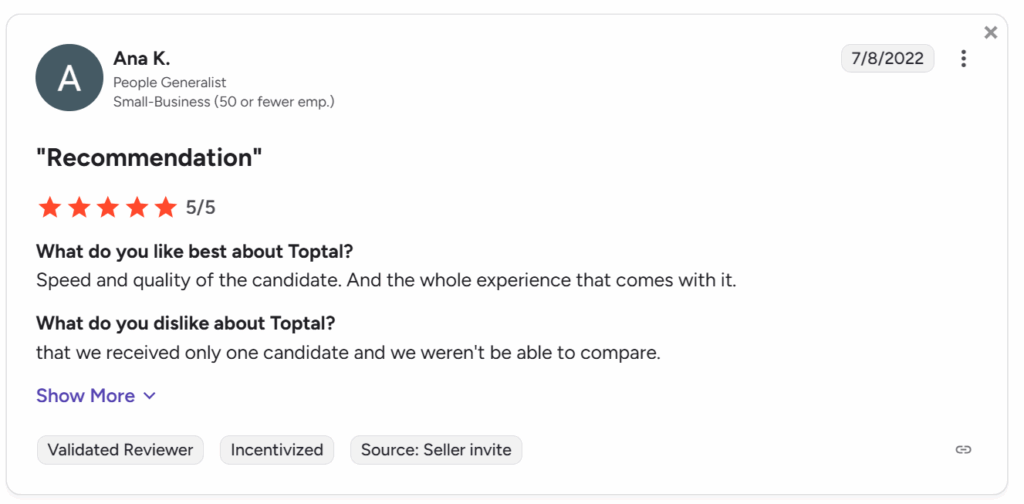
The main knock? Sometimes you only see one candidate, so there’s no real comparison shopping—or chance to push for that unicorn you dreamed about.
Critique: The vetting process is a mixed bag. Yes, it weeds out paper tigers, but several reviews flag that it tends to favor juniors and mid-levels who can pass interviews, rather than veteran devs who can untangle gnarlier problems. So, Toptal can be gold for well-defined projects, but a bit less shiny if your job is solving the tough stuff.
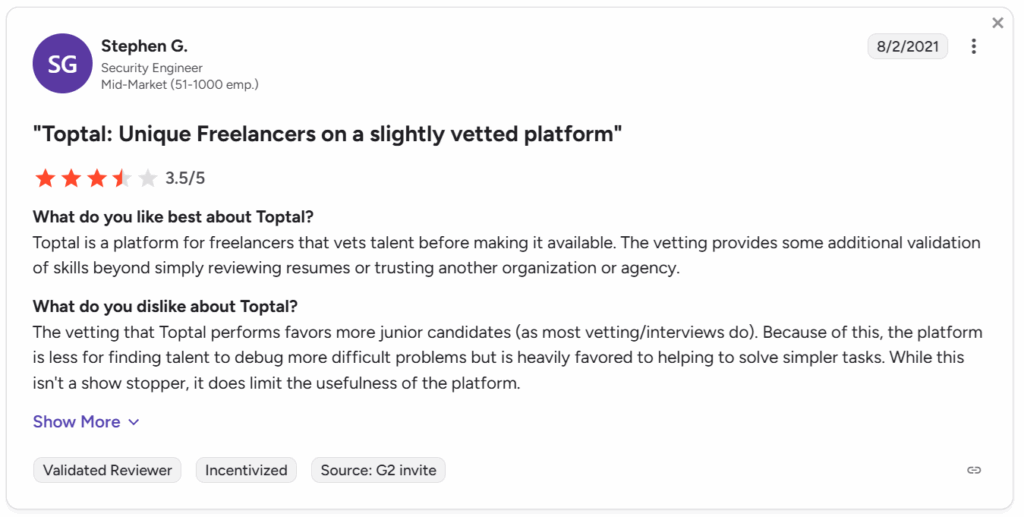
Toptal’s for big budgets, big contracts, and buyers who want a velvet rope—just be prepared to pay for every velvet fiber.
Upwork: The Open Sea of Talent—Bring Your Own Compass

Upwork is the platform for anyone who wants choices. It’s not so much a curated club as a 24/7 global bazaar—thousands of devs, all price points, all experience levels. If you’ve got time to dig, there are bargains and gems. If you want control over every step (and maybe like to play resume detective), this is your playground.
What you get: Massive flexibility, instant access, and a pricing spread that runs from “beer money” to “private island.” You can handpick your freelancer, negotiate directly, and scale up or down with a click. Many buyers find long-term partners here, and Upwork’s infrastructure handles the contracts, payments, and time-tracking so you don’t have to.
Buyers say: “I love the range of talent on Upwork—you can find just about anything, from specialized developers to budget options.” Some reviewers appreciate the payment protection and project management features.
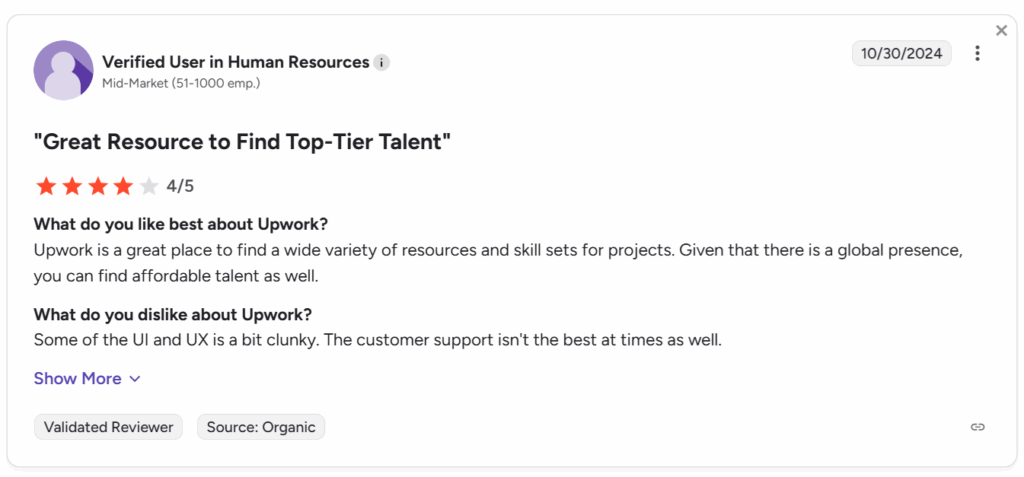
But dig into the review sites and you’ll see repeated complaints about “a 90% or greater fail rate” in finding quality, and warnings that customer support is “very difficult to reach if you need help.”
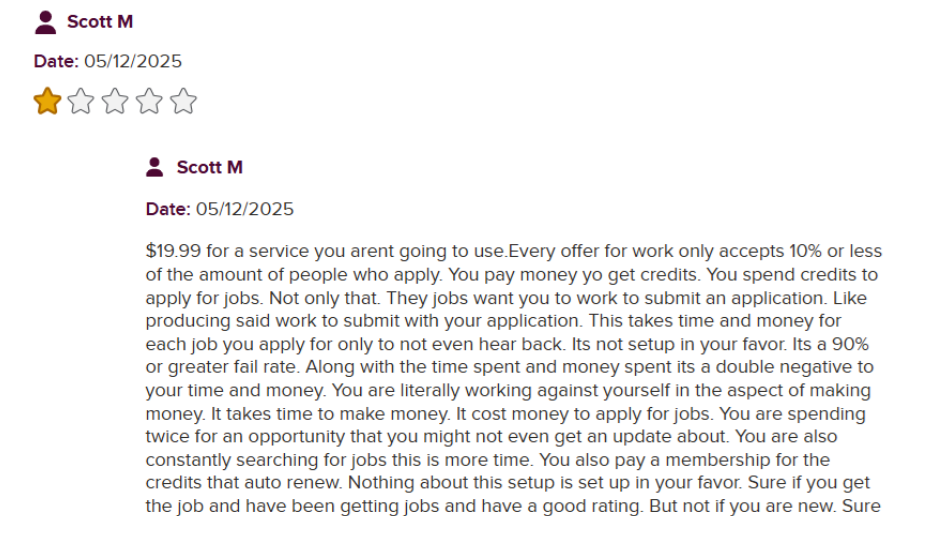
Think of Upwork as the world’s giant developer buffet: great if you know what to look for, a little less fun if you show up starving and indecisive.
Arc.dev: Algorithms Meet Actual Humans (Most of the Time)
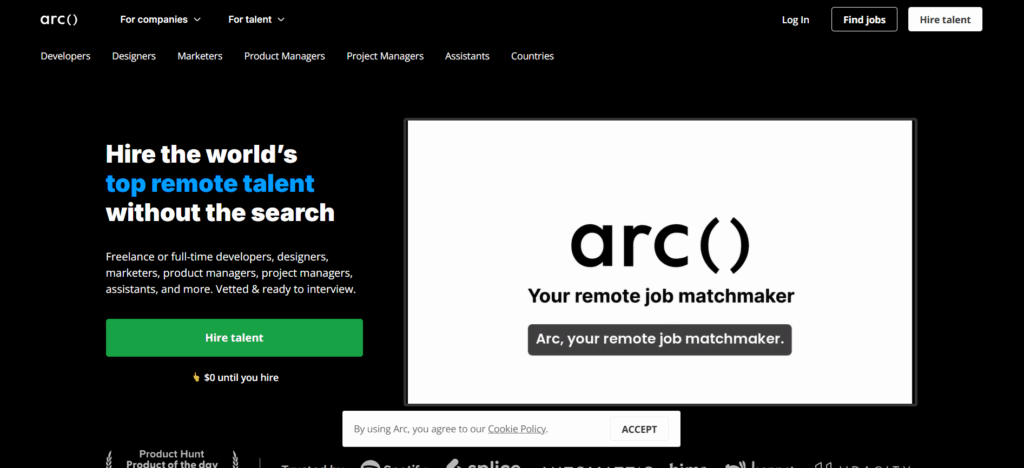
Arc.dev is for those who want AI to do the heavy lifting—without giving up completely on a human touch. Their platform promises quick, smart matching, especially if your wishlist isn’t too wild or your deadline is burning a hole in your calendar.
What you get: Fast, AI-powered pairing combined with enough human curation to keep things from going totally off the rails. Enterprise buyers like the compliance and contracts; startups like avoiding a six-week hunt. No up-front deposits, and the process removes a ton of friction for teams who just want to get started.
Buyers say Arc.dev stands out because, unlike most platforms, you can actually get a human on the line—and they’ll give you real feedback, not just copy-paste talking points. One reviewer mentions being surprised by how much genuine help they got making their resume stand out, and even got a real-life mentor for the job search.
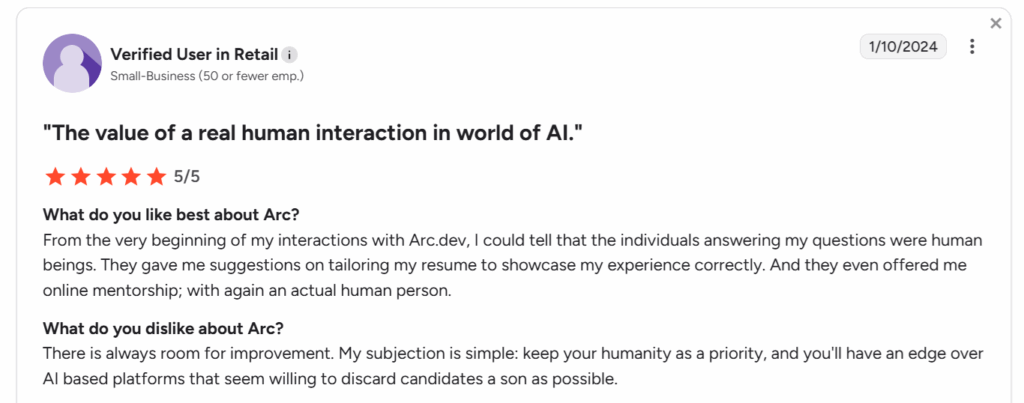
There are also stories from buyers hiring devs across several countries—one called out a hire who climbed the ranks to Engineering Manager. Arc.dev seems to open up your options, and some teams credit the platform for making innovation possible by bringing in new perspectives.
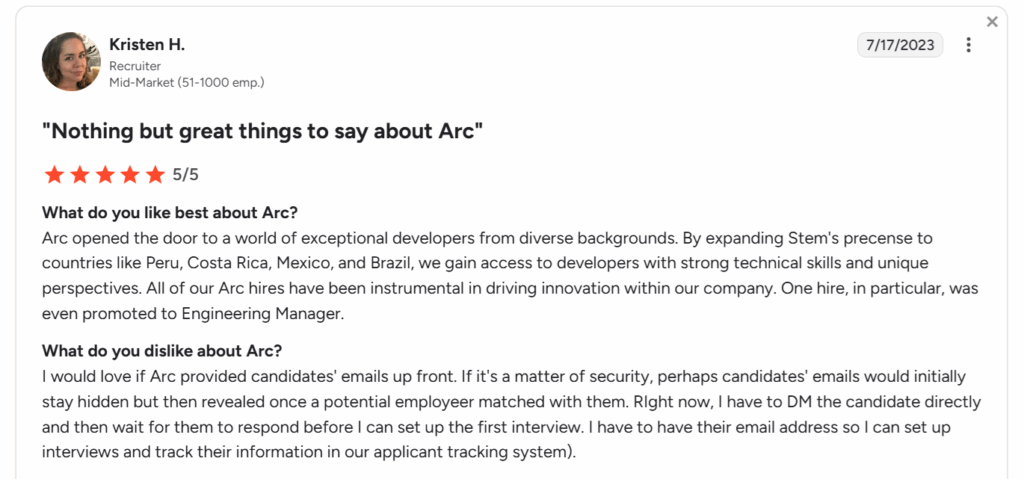
But not everything is perfect. Some users wish they could connect with candidates even faster (hint: emails are hidden at first), and there’s a grumble or two about process quirks that make the initial scheduling slow.
Arc.dev is for buyers who wish hiring felt more like ordering takeout—quick, mostly painless, and way better than rolling dice in a Slack channel.
Fiverr Pro: Freelance Fast Food—It’s Quick, It’s Clear, and Sometimes, It’s Remarkably Good
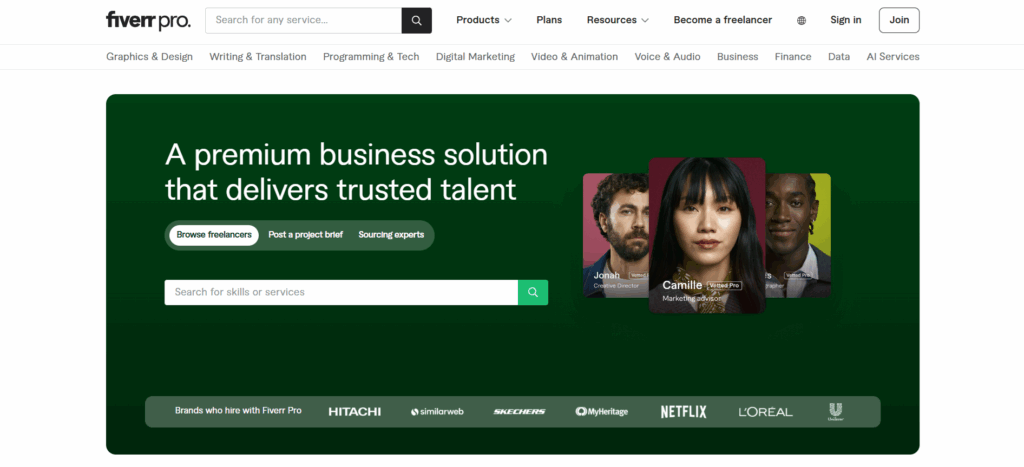
Fiverr Pro is the no-frills, menu-driven answer when you want something done fast and don’t want to negotiate for weeks. Instead of endless proposals, you get a buffet of “Pro” gigs with upfront pricing and turnaround times that sometimes border on the supernatural.
What you get: Simplicity, speed, and a clear project scope from the jump. For one-off builds, design, or smaller features, you can sort by reviews, see portfolios, and hit “Buy Now”—no back-and-forth required. When it goes right, you get crisp delivery and a finished asset while your coffee’s still hot.
Buyers say Fiverr Pro is a great fit for premium projects where you want to pay for reliable, top-tier talent. Reviewers say it’s “worth it for high-profile or time-sensitive projects, and the quality and professionalism really do feel next level.” If you’re after polish, this is where you find your pro.
Pros: People love the “assurance of high quality and professionalism” and the feeling you’re working with a vetted expert instead of rolling dice.

Cons: As expected, you’ll pay extra for the privilege—“Fiverr Pro isn’t cheap,” and some buyers say the pricing stings if you’re on a tight budget.
But real talk: Trustpilot is full of warnings about scams. Negative feedback flags “projects that never happened,” disappearing freelancers, or deliverables that weren’t even close to what was promised. More than one buyer says you need to vet sellers as if you’re on the standard Fiverr marketplace, not just assume the Pro tag means smooth sailing.
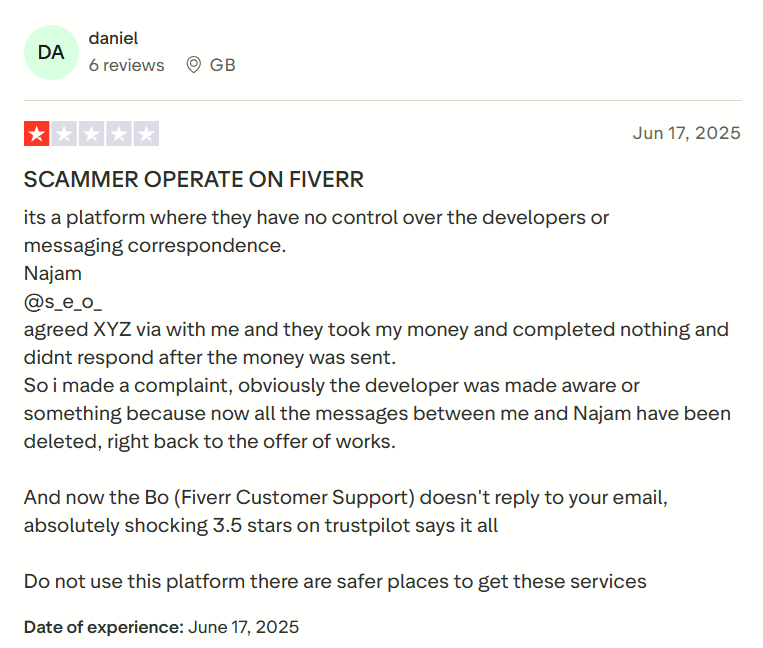
Fiverr Pro works for well-funded projects and teams who want speed, but don’t skip due diligence—or you might end up with an empty inbox and a lesson learned.
Fiverr Pro is for buyers who need work done yesterday and are willing to keep it short, sweet, and to the point. Sometimes you get genius, sometimes just done—but you always know where you stand.
Gun.io: For When You Want U.S. Talent and Don’t Care About the Bill

Gun.io is the platform for buyers who want a tightly vetted, mostly North American engineering pool—and don’t mind paying for it. Their three-stage screening is serious, and when it works, it really works.
What you get: Deep technical interviews, a focus on U.S. timezone overlap, and rapid matching for specialized roles. One buyer says, “Found a senior dev in 24 hours, started work the next day.” Others highlight “transparent, professional service” and credible expertise for complex projects.
What you don’t get: Big scale or budget rates. Some clients say project management can fade out (“Paying the extra overhead of the Gun.io team did nothing to improve the outcome of my project… There was no assistance from the Gun.io team… If that’s the case, then why am I paying a premium to pay for the overhead of Gun.io?”). Freelancers have reported payment issues, like “paid only for 3 weeks and then got banned from the platform”.
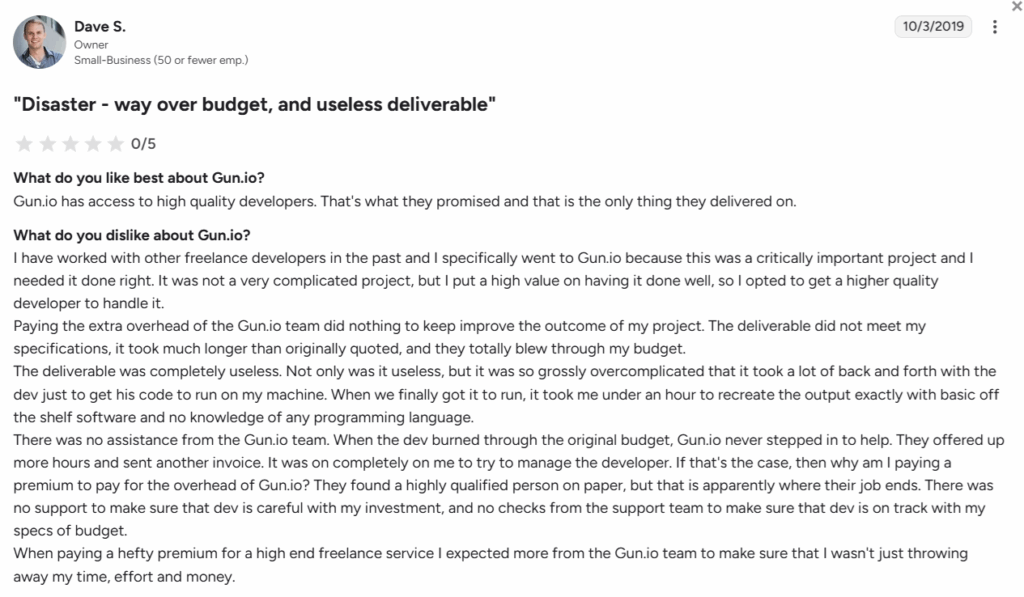
Gun.io fits buyers who want the curated experience of an agency, U.S. talent, and are fine with the bill—but if you need scale or flexible budgets, keep shopping.
What Is Turing, Really? (Origins, Evolution, and the Fine Print)

Turing wants to be the last hiring platform you ever use—at least, if you believe the pitch. Founded in 2018 by two Stanford grads who couldn’t hire fast enough for their own startup, Turing bills itself as “deep vetting + AI matching + global scale.” Their promise: Silicon Valley-level talent, sourced from everywhere, filtered by machine learning, and available on demand.
Today, Turing claims a talent pool of 4 million developers spanning 150+ countries, with customers ranging from household-name giants to sprightly startups. The sweet spot? Mid-market and enterprise clients who need full-time, long-term engineers—not gig project freelancers.
Instead of pure marketplace chaos or agency handholding, Turing walks a line between both: AI does the screening and matching, but once you get a developer, you’re still on the hook for onboarding, management, and making things work. (Think: “Here’s your developer. Good luck!”)
Is the offering as all-powerful as it sounds, or does the reality get fuzzy after the demo call? Let’s dig into the pitch . . . and the footnotes.
The Vetting Process: Claims vs. Reality
Turing’s big flex? AI-powered vetting that promises to weed out the résumé builders and surface only the “Silicon Valley bar” talent. The process sounds rigorous: resume upload, a detailed work history quiz, hours of technical assessments, and finally, a human-reviewed communication screen. Turing says this five-hour battery “helps us vet engineers for Silicon Valley bar skills” and feeds their AI matching engine with “deep developer profiles”.
In theory, that means you’re not just hiring a coder—you’re getting someone who’s passed an endurance test. The platform talks up its machine learning: think gradient-boosted decision trees and algorithms predicting job success based on everything from test results to a developer’s ability to make it through a multi-choice quiz without rage-quitting.
So what happens in practice? The cracks can appear early. Developers report waiting months—sometimes longer—for matches after running the testing gauntlet. Buyers complain of “mismatched skill requirements,” or seasoned pros who stumble once the real work starts. “Strong technical test, but real-world communication didn’t deliver”—that’s a recurring theme on review sites. And forget the chatty hand-holding: several devs mention being ghosted with no feedback after finishing the process.
For a platform that preaches intelligence at scale, the reality filters down to this: the vetting steps are real, the bar is high—but sometimes the humans and machines both miss what matters most for an actual team’s success.
AI Matching and the “Human Touch”: Theory vs. Team Reality
Once you’ve made it through the vetting labyrinth, Turing’s signature move is matching—the AI’s supposed to crunch its data and recommend perfect candidates (you know, “the one” you’d hire if only you had infinite time and a Silicon Valley recruiter on staff). In Turing-speak, their engine uses advanced algorithms to assign every developer a “fit score,” predicting who will thrive on your project.
In practice? It’s a mixed bag. Some buyers report a “great initial match, hired within days.” Others end up running multiple rounds as the algorithm lobs over candidates who look good on paper, but flop in real interviews or fumble culture fit. There are success stories: “Turing got us a senior backend dev in under a week who’s still with us six months later.” But there’s just as much noise about “matches that made no sense for our tech stack,” or developers who aced the Turing tests but didn’t gel with the team.
And while Turing touts “AI and human collaboration,” buyer reviews often come back to this: the AI does the paperwork, but the real judgment (and risk) lands back on your plate. If you want the human touch to weed out the duds, expect to do some of that work yourself
Talent Pool: Depth, Breadth, and Quality
Ask Turing and they’ll tell you they have millions of developers, floating in the cloud ready to join your project—4 million across 150+ countries, to be precise. On the surface, it sounds unbeatable: any skill, any stack, any timezone. But numbers don’t tell the full story.
Most of Turing’s pool clusters around India, Eastern Europe, and Latin America, with an undeniable strength in web and backend dev, cloud, and AI/ML roles. “Top 1%” is the marketing hook, but in reality, it means they’ve passed Turing’s battery of technical and communication tests—not that they’re all Google alumni.
You can filter for region and skill, but the quality claims get stress-tested at scale. Buyer reviews are a mixed bag: some teams find a stellar hire on the first try, others churn through mismatched candidates and wonder where the real “top” talent went. The platform’s sheer size means more choice, but also less curation. And as a bonus, if you need ultra-niche or bleeding-edge tech, your shortlist may shrink fast.
Bottom line: Turing’s depth is real if you’re after popular stacks, but consistency and specific fit still require work—and sometimes luck.
Pricing, Transparency, and Buyer Experience
Pricing on Turing is a bit like chasing a moving target. You won’t find a price list on their site—expect a back-and-forth with sales before you see any hard numbers. Here’s how it usually shakes out, based on client and developer reports:
Pricing Factor |
Toptal |
Lemon.io |
Arc.dev |
Upwork |
Fiverr Pro |
Gun.io |
|---|---|---|---|---|---|---|
Developer Rates |
$65-100/hr frontend, $80-200+ specialist |
$45–$120/hr |
$60–$100+/hr |
$10–$150+/hr |
$100+/hr typical Pro, $30–$200+/hr |
$75–110/hr mid-level, $110–145/hr senior |
Additional Fees |
30–50% markup on dev rates |
20–25% |
One-time 20% of 1st-year salary |
5–10% client fee up to 7.99% |
20% platform fee, $3 under $100 |
20–25%/project (for permanent placement) |
Deposits/Commitments |
$500 mandatory deposit |
None |
$300 deposit |
None |
None |
No upfront, but minimum 20 hrs/week |
Subscription/Platform Fee |
$79/mo platform access (optional) |
None |
None |
None |
$129/mo for Advanced Plan (opt.) |
None |
Trial Period |
2 Weeks |
1–2 Weeks |
2 Weeks |
N/A |
N/A |
Varies |
Transparency |
After signup |
Direct |
Direct |
Direct |
Direct |
Direct |
Turing’s markup is among the highest in the industry. Clients often pay $100 an hour but their developer might see less than half of that. On the plus side, there’s no deposit or subscription, and you get a risk-free trial period to kick things off.
Buyer experience: Some report onboarding is smooth and support is fast—especially for big accounts. Others have been blindsided by unclear pricing, stall-outs in communication, or find themselves untangling who’s responsible for what once a match is made. And when things go sideways? Support can be helpful or MIA, depending on the day.
Bottom line: If you’re cost-conscious or value radical transparency, bring questions and a healthy skepticism to your Turing sales call. If you care most about “done for you” curation and have a budget to match, Turing’s platform experience is comfortable—just keep an eye on your effective hourly rate.
Turing’s Strengths and Where It Trips Up
Here’s where Turing delivers: you want to hire a bunch of devs at once, across nearly any tech stack, without spending the next quarter buried in LinkedIn DMs. Turing’s superpower is scale—if you need warm bodies, fast, you’ll get them. The platform is built for teams who already know how to manage remote engineers and want speed, not endless hand-holding. There’s a comfort in the brand and a certain Silicon Valley gloss from the trial period, the push-button onboarding, and—sometimes—the sheer depth of the talent pool.
Now, the flip side: If you expect white-glove curation or think Turing will baby your project, you’re in for a surprise. High-touch support is hit-or-miss, and the algorithm is no substitute for an engaged account manager. Niche roles and true “wow, they fit our culture” picks still require heavy lifting on your end. For some buyers, it’s seamless; for others, the handoff from AI to “now you figure it out” feels like being dropped mid-marathon.
Want speed, scale, and the kind of platform that’s always pitching “next-gen matching”? Turing’s your tool. Want a squad that sweats the details and hand-picks every fit? You’ll miss the human touch. Just know what you’re signing up for before you hit “get started.”
The Verdict: Who Should Use Turing—and Who Should Pass
If you want lots of choices and don’t mind a little chaos, Turing fits. Throw your specs into the machine and you’ll get a crowd—sometimes a good one, sometimes not. You’ll move fast, but you’ll still need to steer.
If you expect someone else to sweat the details, prepare to be disappointed. Culture fit and creative thinking aren’t always things an algorithm can spot. If you need a partner who actually learns your quirks, look elsewhere.
Most buyers get results as long as they come in with open eyes and hands on the wheel. If you want less sorting, more straight talk, or your next hire to feel like a handshake, look at Lemon.io.
Curious how hiring can feel less like a lottery? Try Lemon.io today.









